
Pleshkover toys
russian version
Anthology creative activity families Frolovs
Phone: +7 0862 421823
![]()
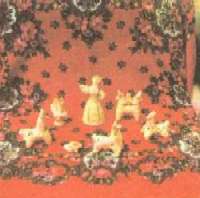
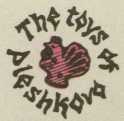 |
“Many people today are trying to find the roots of their culture with a hope to find their future, to preserve their national dignity. The spiritual revival of folk arts will help us on this hard way”. |
Craftswoman N. FROLOVA.
The toys of Pleshkovo — are one of the ancient traditional trades of the center of Russia. The village of Pleshkovo (Livny district, Orel region) has been known since the 17th century. According to the legend there were woods around the village, but because of the scantiness of land here a “bald spot” appeared. This gave the name to the village — Pleshkovo as “Bald spot”. The clay in this area is special. After being burnt it acquires the warm pink color with silvery dots of mica. Since the old days the people of Pleshkovo have been making pots and bowls of clay. “They made kitchen utensils which reminded of the sound of bells”,— remembered the old people.
|
To entertain the kids and to please themselves, the craftsmen modeled toys-whistles. We know the names of original toy-makers Olga Danilovna Malutina (1885—1974) and Alexandra Michailovna Ivanilova (1911— 1990). At present only followers of Ivanilova A. M. the craftsmen Natalia Nickolaevna Frolova (1955) and Alexandr Vicktorovich Frolov (1956) continue making the toys of Pleshkovo. Their children Alexandre and Anna are also showing great promise. The works of these craftsmen could be seen at museums and exhibitions of folkart, at different festivals and folk shows. The toys of Pleshkovo had a great success at festivals in Germany, France and the USA. |
||
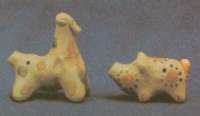 |
From generation to generation the craftsmen have been modeling one form bequeathed to them by their ancestors, slightly changing it, giving to this form a new meaning. The toys are not merely for children's entertainment. The toys of Pleshkovo managed to preserve its archaism, which goes deep into history, when these toys participated in magic rituals and served as totems and gods. |
|
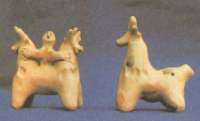 |
The citizens of this area affirm that in the old times the traditional festivals “Svistunya” (Whistlers) took place on the land of Orel. The shrilling whistles were to turn the dark forces which had been piled up during the winter time out of hearts and houses. The Frolovs craftsmen suppose that the decoration of the toys — free dots made with natural colors of grounded red brick and burdock sap — are the ancient marks of a spike and grass which are characteristic of May (the old Russian name is “Traven”) in the Slavonic calendars. This festival in former times had a ritual and traditional meaning. |
|
 |
The domestic animals and poultry are the favorite subjects of craftsmen from Pleshkovo. Since the old times their figures have been keeping all the meanings of the traditional Russian pantheon, which are conducive to the good. Bird (a cock, a hen, a duck) — the main ancient meaning is to protect, symbolized spring, warmth. The bird is a symbol of the revival of nature, of spring. It predicts a good crop. “Where there is a duck, there is good rye”. The cock is a representative of a thunder flame, which lights the sum. |
|
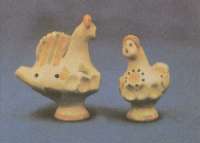 |
A bird with a woman's face. The southern Slavic tribes considered the bird-girl to be a symbol of vegetation and of a good crop. She was living on the trees and flying over the fields. A. S. Pushkin mentioned a bird-girl in one of his poems. A deer — a symbol of the sky, of a happy marriage and of Slavic Goddesses — giving birth to everything alive. Russian Trinity — a figure of a human being is placed between the two deer’s (a symbol of a woman in childbirth). It's a symbol of a super God Origin which determines the future. |
|
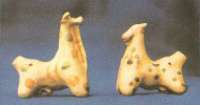 |
A horse and a rider — a symbol of sky and sun are crossing the sky in a chariot, a symbol of fertility and good weather. Boat (Ladya) — one of the variants of the “Russian Trinity”. Ifs the two horses grown together and the Goddess Surya is between them. She is the daughter of the God of Sun (the main God of the ancient Slavic tribes). Surya was the wife of twin brothers — the Ashvins — the riders. The horses on the right and on the left symbolize the sunrise and sunset. Spring is on the right hand side And autumn is on the left The main function is to give a helping hand to people. |
|
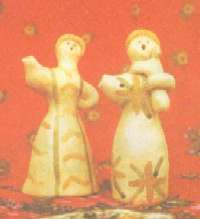 |
Ram (sheep) — a symbol of wealth, nobility and prosperity. Cow or (She-goat) — a symbol of fertility which comprises the bread ghost of a field. There is a belief— if one sees spikes wavering in the wind — it means that “the rye goat or a cow” is wandering in the rye field. Woman (baba) — close relations with the culture of our ancestors are reflected in the image of a peasant woman of Pleshkovo. Thousands of years separate us from the culture of Tripoli, but the plastic art of Pleshkovo remarkably has much in common with the figure of the ancient Goddess who is taking care other home. She is a symbol of fertility. The figure of a peasant woman (baba) is modeled in the same way: a pinched nose, the same headwear and a short arm with a whistle. The decoration of a peasant woman of Pleshkovo consists mainly of solar marks: a double cross and free spots with small dots. Sometimes one can see vertical lines — a symbol of falling rain — and wavy lines — that means the land full of water. Nature and femininity are combined in the image of the Great Goddess — the Mother-Earth. |
Contact : oreltoys@narod.ru
29.10.2005